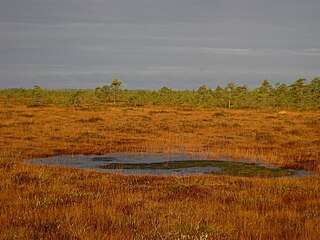
The Ramsar Convention on Wetlands of International Importance Especially as Waterfowl Habitat is an international treaty for the conservation and sustainable use of wetlands. It is also known as the Convention on Wetlands. It is named after the city of Ramsar in Iran, where the convention was signed in 1971.

The Macquarie Marshes Nature Reserve is a protected natural wetland reserve that is located within the Macquarie Marshes, in the region along the lower Macquarie River in northwestern New South Wales, Australia. The 19,824-hectare (48,990-acre) reserve is situated approximately 600 kilometres (370 mi) northwest of Sydney and 100 kilometres (62 mi) north of Warren.
A Ramsar site is a wetland site designated to be of international importance under the Ramsar Convention, also known as "The Convention on Wetlands", an intergovernmental environmental treaty established in 1971 by UNESCO, which came into force in 1975. It provides for national action and international cooperation regarding the conservation of wetlands, and wise sustainable use of their resources. Ramsar identifies wetlands of international importance, especially those providing waterfowl habitat.

Matsalu National Park is a nature reserve and national park situated in Lääne and Pärnu Counties, Estonia. Matsalu National Park spans an area of 486.1 km2 (187.7 sq mi), comprising Matsalu Bay, the Kasari River delta, the village of Matsalu and surrounding areas.

Protected areas of Poland include the following categories, as defined by the Act on Protection of Nature of 16 April 2004, by the Polish Parliament:

The Queen Maud Gulf Migratory Bird Sanctuary is Canada's largest federally owned protected area, encompassing some 61,765 km2 (23,848 sq mi) of the Arctic Circle coastline. 6,710 km2 (2,590 sq mi) are marine, and 55,055 km2 (21,257 sq mi) are terrestrial.

Alam-Pedja Nature Reserve is the largest nature reserve in Estonia. It is a vast wilderness area which covers 342 km2 and consists of a complex of 5 large bogs separated by unregulated rivers, their floodplains, and extensive forests. The nature reserve aims to protect diverse ecosystems and rare species, mainly through preserving the natural development of forests and bogs and securing the continuing management of semi-natural floodplain grasslands.
Jubho Lagoon is a large shallow brackish lagoon located in Sindh, Pakistan. In May 2011 Jubhoo lagoon was inducted into the list of Ramsar sites, consisting of wetlands of international importance.

Endla Nature Reserve is a nature reserve situated in central Estonia.

Agusalu Nature Reserve is a nature reserve situated in eastern Estonia, in Ida-Viru County.

Muraka Nature Reserve is a nature reserve situated in eastern Estonia, in Ida-Viru County.

Sookuninga Nature Reserve is a nature reserve situated in south-western Estonia, in Pärnu County.

Laidevahe Nature Reserve is a nature reserve situated on Saaremaa in western Estonia, in Saare County.

Chowilla Regional Reserve is protected area in the Australian state of South Australia located in the gazetted locality of Chowilla about 250 kilometres (160 mi) north-east of the state capital of Adelaide.

Chowilla Game Reserve is a protected area covering the floodplain on the north side of the River Murray in South Australia from about 8 kilometres north-east of Renmark to the New South Wales border. It was proclaimed 8 April 1993 in conjunction with the Chowilla Regional Reserve, after a community consultation process which recommended that "hunting of waterfowl be a permitted activity in selected areas of the Chowilla floodplain". The game reserve is classified as an IUCN Category VI protected area.

Käina Bay is almost isolated and very shallow approximately 9 km2 (3.5 sq mi) marine area between the Estonian islands Hiiumaa and Kassari, which is connected to the surrounding Väinameri and adjacent Vaemla Bay via three tiny channels - Orjaku channel, Orjaku sill and Vaemla channel. The maximum depth of Käina Bay is about 1 meter. Käina Bay is separated from the Väinameri Sea by Kassari Island, Õunaku Bay and Jausa Bay by a dyke road. There are many thickets of reeds and islets (23). In the southern part of the bay there is mineral curative mud.












